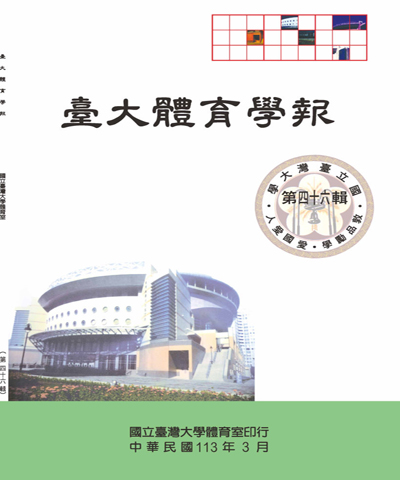
臺大體育學報
- OpenAccess
國立臺灣大學體育室,正常發行
選擇卷期
- 期刊
- OpenAccess
Yoga Asanas have been used as one of the methods that can help imporove one's physical fitness and health since long time ago. While it was not known much about how asanas affect on health-related physical fitness. Therefore, the purpose of this study was to investigate the effect of yoga asanas on health- related physical fitness. Eighty collage female students were served as subjects of this study (average age was 20.6), and thirty yoga asanas were taught during a seven-week section. During the section, subjects was trained 100 minutes and asked to practice twice a week (total 60 minutes). Several physical fitness were tested before and after the section. It was found that there were significant differences on cardiovascular capacity, muscle fitness, flexibility and body composition after the section (p<.01). This study concluded that yoga asanas had a positive effect on health-related physical fitness.
- 期刊
- OpenAccess
This study investigated the propulsion generated by AS, LK and WS of backstroke swimmers and compared the exercise intensity of AS and LK. Also, the percentages of WS propulsion accounted for by AS and LK propulsion respectively are examined. Twenty excellent swimmers nationwide (12 males and 12 females) were studied, age 17.0±2.0 years (male), 15.17±2.12 years (female); height 171.08±5.72cm (male), 162.29±5.93cm (female); weighte 60.46±8.58kg (male), 54.17±4.26kg (female); years of training 7.25±2.14 years (male), 6.25±2.34 years (female). An identical subject with repeated measure design and a balanced-order testing sequence were used. A pulley weight system, Power-Pack, was used to deters mine propulsion for AS, LK and WS. Under water heart rate monitor was used to determine the exercise intensity by measuring the changes in the heart rates of swimmers before and after the test. The 100 M WS unimpeded swim time was the time for AS, LIC and WS. It was found that WS generated the, highest propulsion for both male and female backstrokers (6.35±2.19 kg•m/sec for males and 3.93±0.38kg•m/sec for females), followed by AS (2.98±1.08kg•m/sec for males and 1.75±0.31 kg•m/sec for females) and by LK (2.53±1.08 kg•m/sec for males and 1.68±0.24 kg•m/sec for females). AS propulsion accounted for 46.87% of WS propulsion for males and 44.34% for females. LK propulsion accounted for 39.44% of WS propulsion for males and 42.84% for females. From a statistical perspective, LK propulsion is very close to AS propulsion for both male and female backstrokers, which demonstrates that LK, contrary to what is generally believed, is more than just a stablizer in the coordination process of backstroke swimming. Males may be faster swimmers than females and procuced more propulsion, yet the coordinations skills (when doing WS) shown by males and females (13.69 % of WS for males and 12.66% of WS for females) are not substantially different. [skill coordination=WS propulsion-AS propulsion-LK propulsion)/WS propulsion, a quantifiable indicator of backstrokers coordination skill] Change in heart rate is biggest during LK for male backstroders (58.33±13.86 bp/min), followed by WS (58.08±16.42 bp/min) and by AS (46.75±6.74 bp/min). For female backstrokers, WS caused the biggest change in heart rate (67.50±11.74 bp/min), followed by LK (60.83±10.47 bp/min) and by AS (43.25±16.14 bp/min). Male or female, change in heart rate during LK is greater than during AS, while changes in heart rate during LX and WS are very close, which induces us to believe that exercise intensity during LX and WS is very close. Conclusion: Propulsion and exercise intensity were major factors that affect the speed and training effectiveness of backstrokers. AS propulsion is not substantially greater than LK propulsion in backstroke swimming, so AS and LK are equally important in their contribution to backstroke swimming. Further, it is possible to quantify swim skill coordination. More LX should be used for anaerobic training to increase exercise intensity as well as the speed of backstroke swimming.
- 期刊
- OpenAccess
本研究的目的在於: (一)探討各級選手的左右移位對牆低手傳球能力、前後移位對牆低手傳球能力以及接發球能力的相關。 (二)建立複迴歸公式,預測接發球能力。 研究結果發現 (一)各級選手的左右移位對牆低手傳球能力、前後移位對牆低手傳球能力以及接發球能力三者之間均有顯著相關存在。 (二)預測第一級選手之接發球能力(x)的複迴歸公式爲 x=0.248(左右移位對牆低手傳球能力)-0.072(前後移位對牆低手傳球能力)+49.324。估計標凖誤(S)=1.528。 (三)預測第二級選手之接發球能力(x)的複迴歸公式爲 x=0.061(左右移位對牆低手傳球能力)+0.263(前後移位對牆低手傳球能力)+33.402。估計標凖誤(S)=6.148。 (四)預測第三級選手之接發球能力(x)的複迴歸分式爲 x=0.056(左右移位對牆低手傳球能力)+0.511(前後移位對牆低手傳球能力)+13.765。估計標凖誤(S)=2.407。 (五)不知等級的受試者之預測接發球能力(x)的複迴歸分式爲 x=0.127(左右移位對牆低手傳球能力)+0.277(前後移位對牆低手傳球能力)+19.817。估計標凖誤(S)=10.163。
- 期刊
- OpenAccess
本研究予題係台大學主對校內運動競賽之意見調查系列研究的第一部分,以台大學生對校內運動競賽之意見調查問卷爲研究工具,對台大學主實施調查籍以瞭解台大學主對校內運動競賽事務的意見及不同背景學生對校運動內競賽事務的意見及不同背景學主對校運動內競賽事務意見之差異。 調查結果,經資料處理與分析後,獲得下列結論: 1.報名時設立服務處及熱線電話是學生對校內運動競賽最殷切需要的事務,其次是趣味性比賽之需求,而需求程度最低的是全校運動會分平級比賽。 2.絕大部分的同學(84.2%)認爲全校運動會應每年舉辦,且開幕典禮及運動員統場傾向由運動員(51.4%)或自由參加(34.5%),而對表演項目之需求,持正面態度的比率是反面態度者的二倍。 3.獲得校內運動競賽消息主要來自廣告海報(42.2%)及同學告知(42.0%),主要是從體育教師獲得消息的比率不及5%。雖然廣告海報是消息獲得主要來源文一,但仍有七成以上對校內運動競賽消息的發佈表示否定的看法。 4.全校最熱烈的校內運動競賽是新生盃,而校內運動競賽組隊的方式最好以系爲單位,其次爲依比賽性質而定。 5.女生在趣味性比賽的需求程度高於男生,也比男生較不排斥運動會表演節目,男主則在報名時設立服務處及電話熱線、組織校內運動競賽促進會、舉辦院系運動會等事項的需求程度高於女生。 6.夜間部、法學院、文學院及醫學院學生在趣味性比賽的需求程度較高,工學院對舉辦院系運動會的需求程度最高,醫學院學生較傾向開幕典禮應由運動員參加繞場。 7.年級愈高對運動會表演項目的需求程度愈低,大學部學生隨年級升高增加其對校隊同學擔任裁判的信任,低年級同學對校內運動競賽消息比較仰賴同學或學會的告知。 8.參加次數越多者有對趣味性比賽的需求度越低、越信任代表隊擔任裁判、越關心校內運動競賽結果。
- 期刊
- OpenAccess
本研究主要目的在探討游泳運動能力中的耐力、速度、技術間之相關,受試對象34名,進行測驗及技術評量後,所得資料經皮爾遜積差相關統計分析後獲得下列結論: 一、游泳耐力與蝶泳、仰泳、捷泳速度之間有正相關。 二、耐力與技浙 1.男子游泳耐力與四種姿勢技術之間有正相關。 2.女子游泳耐力與捷泳技術之間有正相關。 三、速度與技術 1.整體而言男子的蝶泳、仰泳、捷泳速度與技術之間有正相關。 2.整體而言女子蝶泳、仰泳、捷泳速度與捷泳的技術之間有正相關。
- 期刊
- OpenAccess
本研究的目的在於探討國內大學學生對其校內體育運動設施及器材的使用滿意度會受到那些因素的影響,本究所得的結果與發現將可做爲日後學校及社會上各種體育運動團體、組織及機構等做爲改進及規劃體育運動設施及器材使用之參考。本研究是以集束抽樣法選取國內大學院枚的5,585位大學制日間部男女學生做爲研究對象來填寫問卷。使用滿意度的評量方式分爲1-5個等級,分別爲: (1)非常不滿意(2)不滿意(3)非不滿意也非滿意(4)滿意(5)非常滿意問卷資料經統計分析得出下列結論:性別、平齡、年級、是否爲運動社團團員或運動代表隊隊員、居住狀況、家庭收入、使用頻率、使用時間、使用成員,使用人數,以及有否使用其它校外的體育運動設施等因素分別是影響各種不同體育運動設施及器材使用滿意度的因素。
- 期刊
- OpenAccess
本研究者在瞭解國立臺彎師範大學游泳消費各對游泳池活動訊息來源、從事游泳運動之生活習性、參與動機,入會前之考慮因素,以及對游泳池相關設備和管理人員服務態度的看法。研究對象爲345位臺灣師大牌泳池之會員,其中包括:師大學生、數職員工(含退休或兼任)、師大及附中教職員工直系親屬及配偶、師大校友及校外人士等。並以「國立臺灣師範大學游泳池消費者行爲調直問卷」爲研究工具進行現場問卷調直,根據回收的問卷整理後,分別以描述性統計、百分比、次數分配及卡方考驗等統計方式加以分析整理,其研究結果發現: 一、消費者對游泳池活動訊息來源及從事游泳運動之生活習性方面: 國立臺灣師範大學游泳消費者對游泳池訊息來源主要是以校內之宣傳布條、海報等刊物佔(38.25%)的人數比例最高,從事游泳池運動時成員以自己一個人比例爲最多佔(66.58%),游泳場所大部份以學校內之公立游泳池爲生佔(88.41%),游泳池運動的頻率以幾乎每天都去特泳所佔人數最多(36.52%),至於游泳的時間以晚上(18:30~21:00)爲最佳的選擇佔(65.8%)。 二、在參與動機方面: 消費者之參與動機依序爲「爲保持身體健康」、「培養一個終身的休閒活動」、「消除疲勞、提振精神」。 二、從事游泳運動所優先考慮的因素依序爲: 「溫水游泳池」、「游泳池水質品質佳」、「離家距離近」 三、對游泳池各項設備整體性評估: 消費者大多數滿意(76.24%),尚可者(16.12%),不滿意者僅佔(7.54%)。 四、對管理人員的服務態度整體性評估: 滿意者佔大部份(82.90%),尚可者(13.04%),不滿意者僅佔(4.06%)。從四、五兩點滿意度來看,可以發現消費者對臺灣師大游泳池各項設備以及管理人員的服務態度滿意度很高。

